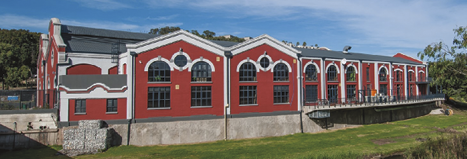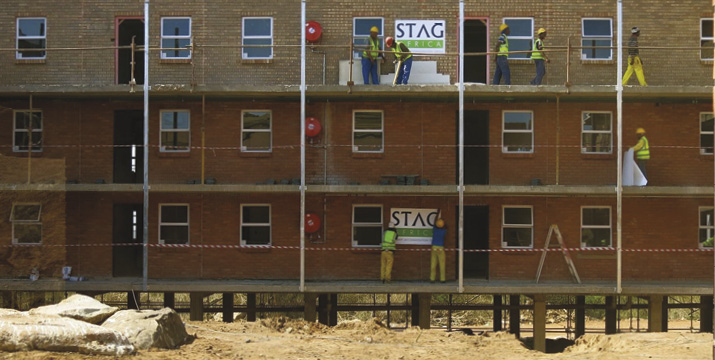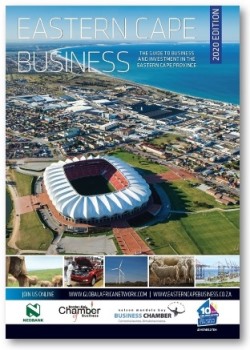The University of Fort Hare is the site of a huge student housing project (above). The second phase of the student village will cost R400-million. Student accommodation specialists STAG African will create a student centre and postgraduate options, having delivered 610 beds in the first phase.
When the project is complete, the university will have the highest ratio of beds to students in South Africa, with a total of 2 047 beds. The project is jointly funded by the European Union, the National Department of Higher Education and Training and the Development Bank of Southern Africa.
STAG African is responding to a national (and continental) trend because one of the fastest-growing segments of the property market is student accommodation. Ambitions to keep making tertiary education more accessible to a broader range of students has been successful since South Africa became a democracy in 1994 and this has created a need for accommodation. The Department of Higher Education and Training estimates that there is a need across South Africa for 250 000 beds for university students.
These factors apply to the province’s other universities such as Nelson Mandela (Port Elizabeth and George), Rhodes (Grahamstown) and Walter Sisulu (four campuses including Mthatha and East London), together with all the TVET colleges.
Fort Hare University recently completed a library building in East London that also serves the students of Walter Sisulu University and UNISA. Construction company GVK-Siya Zama faced some challenges on a constricted site, but delivered basement parking and four levels of offices, boardrooms, study areas and a canteen. The library is on three levels.
The same company was active on the project to rebuild Woodridge College after that institution was devastated by fire in 2016. Another project that required the demolition of buildings was at David Livingstone High School in Port Elizabeth. This R64-million project created a new double-story classroom block, kitchen and dining hall.
Housing
Coastal properties almost always attract a premium, but a new trend towards “semigration” is further boosting prices. Semigration refers to families who live in towns like Knysna or George but the bread-winner commutes to Johannesburg. Towns such as St Francis Bay, Jeffreys Bay and Port Alfred are now becoming the sites of primary residences, instead of being exclusively holiday destinations.
A major stimulant in the housing sector is government. In 2019 the Eastern Cape Provincial Government claimed to have built 500 000 houses in the term of office of the administration that started in 2014.
A new housing development in the rural area of Keiskammahoek attracted funding of R25-million from the Eastern Cape Provincial Department of Human Settlements. Aimed at destitute families, the first phase was conducted in the settlement of Masincedane, and the project will ultimately cater to 1 255 beneficiaries.
Large-scale housing projects often demand unique lighting requirements. The Buffalo City Metropolitan Municipality called in large-area lighting specialists Maritz Electrical for the lighting of its informal settlements. The introduction of LED lighting on 20 meter masts will provide a measure of security and maximise energy efficiency.
A remarkable transformation has taken place in downtown Port Elizabeth. The old “Sanlam” building, which used to house one of the country’s most notorious security branch torturers, has been converted into social housing. Together with two other buildings (Mumford House and the Old Mill Building) the area has been named the Steve Biko precinct in honour of the Black Consciousness leader and will offer a heritage aspect in the form of a museum. The room in which Biko was tortured has been preserved as a historical site.
The Qhama Social Housing Institute offers accommodation from R1 200 per month and is targeted at the “missing middle”, people who can’t afford a bond and who don’t qualify for an RDP house. These people are entitled to a housing subsidy.
Transformative development
One of the largest malls to be constructed in South Africa in the new century has made a big impact on the western edge of Port Elizabeth. With 250 shops, an ice rink and cinemas, the R2-billion Baywest Mall is the first part of what will become the 320 ha Baywest City Precinct on the N2. The giant development spurred a R300-million upgrade at Greenacres, the city’s first big mall development which attracted shoppers away from the central business district (CBD) in 1981.
 The Mandela Bay Development Agency (MBDA) has transformed the Old Tramway building (left) at the entrance to the Baakens Valley. The MBDA not only moved into new offices in the renovated building but is letting it out as an events venue. Other retail property developments have happened in the valley (including a popular brewery), drawing attention to the potential of Port Elizabeth’s green lung to be even more useful in future.
The Mandela Bay Development Agency (MBDA) has transformed the Old Tramway building (left) at the entrance to the Baakens Valley. The MBDA not only moved into new offices in the renovated building but is letting it out as an events venue. Other retail property developments have happened in the valley (including a popular brewery), drawing attention to the potential of Port Elizabeth’s green lung to be even more useful in future.
The Baakens River Valley is one of Port Elizabeth’s hidden gems and the MBDA has commissioned studies on how the valley might best be utilised for leisure and new housing without compromising its unique natural features.
A scheme to restructure the yacht basin in the harbour is planned. A key blockage is the location of manganese storage dumps on the edge of King’s Beach. When those are moved to the Port of Ngqura, the marina development can go ahead.
Online resources
- Construction Industry Development Board: www.cidb.org.za
- Mandela Bay Development Agency: www.mbda.co.za
- Qhama Social Housing Institute: www.qhama.co.za
- Social Housing Regulatory Authority. www.shra.org.za
- South African Property Owners Association: www.sapoa.org.za




